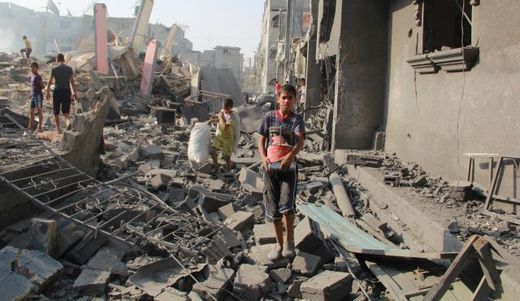Asmaa al-Ghoul, a journalist from the Rafah refugee camp in Gaza, writes for Al-Monitor:
Tears flowed until my body ran dry of them when I received a telephone call on Aug. 3, informing me that my family had been targeted by two F-16 missiles in the city of Rafah. Such was the fate of our family in a war that still continues, with every family in the Gaza Strip receiving its share of sorrow and pain.
My father’s brother, Ismail al-Ghoul, 60, was not a member of Hamas. His wife, Khadra, 62, was not a militant of Hamas. Their sons, Wael, 35, and Mohammed, 32, were not combatants for Hamas. Their daughters, Hanadi, 28, and Asmaa, 22, were not operatives for Hamas, nor were my cousin Wael’s children, Ismail, 11, Malak, 5, and baby Mustafa, only 24 days old, members of Islamic Jihad, the Popular Front for the Liberation of Palestine or Fatah. Yet, they all died in the Israeli shelling that targeted their home at 6:20 a.m. on Sunday morning.
Their house was located in the Yibna neighborhood of the Rafah refugee camp. It was one story with a roof made of thin asbestos that did not require two F-16 missiles to destroy. Would someone please inform Israel that refugee camp houses can be destroyed, and their occupants killed, with only a small bomb, and that it needn’t spend billions to blow them into oblivion?
If it is Hamas that you hate, let me tell you that the people you are killing have nothing to do with Hamas. They are women, children, men and senior citizens whose only concern was for the war to end, so they can return to their lives and daily routines. But let me assure you that you have now created thousands — no, millions — of Hamas loyalists, for we all become Hamas if Hamas, to you, is women, children and innocent families. If Hamas, in your eyes, is ordinary civilians and families, then I am Hamas, they are Hamas and we are all Hamas.
Throughout the war, we thought that the worst had passed, that this was the pivotal moment when matters would improve, that they would stop there. Yet, that real moment of pain, of extreme fear, was always followed by something even worse.
Now I understood why the photographs of corpses were so important, not only for international public opinion, but for us, the families, in search for an opportunity to bid farewell to our loved ones, so treacherously killed. What were they doing in those last moments? What did they look like after their death?
I discovered the photos of my dead relatives on social networking sites. The bodies of my cousin’s children were stored in an ice cream freezer. Rafah’s Abu Yousef al-Najjar Hospital was closed after being shelled by Israeli tanks, and the Kuwaiti Hospital that we visited just a day earlier had become an alternate venue, where this freezer was the only option available.
(Featured Photo: Destruction in Rafah after Friday’s Israeli attacks)

